Put Out the Welcome Mat in Your Garden for Leafcutter Bees
With approximately 4,000 bee species in North America, the opportunities for observing bees in the garden are endless. Leafcutter bees (Megachile) are charismatic bees and commonly appear in urban and suburban gardens. Their antics will likely brighten your day: Females often scoot across flowers laden with pollen, collecting it on their undersides as their abdomens turn bright orange or yellow, depending on the pollen from the flower they just visited. When not collecting pollen, females forage on flowers and turn the end of their abdomen upward.
The common name, leafcutter bee, is derived from the female’s method of collecting nesting materials. Females chew pieces of leaves, either oval or circular in shape, with their large, sharp mandibles (teeth), and then carry each leaf piece under their abdomen as they fly back to the nest.
By providing a diversity of flowering plants throughout the growing season, and tolerating a few leaf cuts on certain plants, you will be delighted in return by having leafcutter bees flying in your garden.
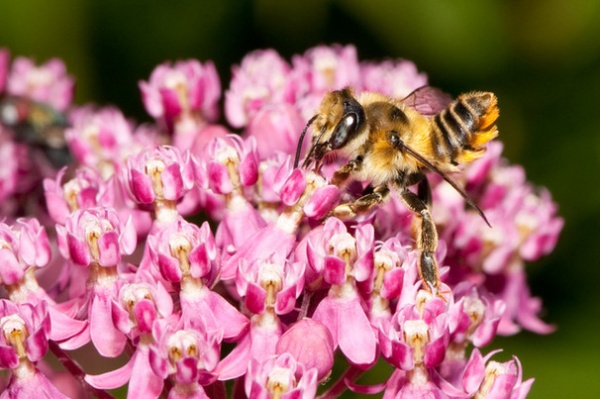
Genus: Megachile
Common name: Leafcutter bee
Numbers: Approximately 16 subgenera and 135 species in North America (north of Mexico), including 6 introduced species, 44 species east of the Mississippi and 1,510 species worldwide
Distribution: Leafcutter bees are found throughout most of the world, including Asia, Africa, Australia, Europe, South America and North America.
Habitat: Woodland edges, gardens, meadows, prairies and old fields
Shown: Female leafcutter bee foraging with the abdomen upturned on swamp milkweed (Asclepias incarnata), a characteristic pose of females
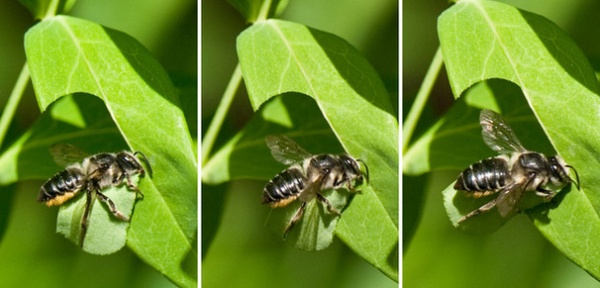
When to look for them: Leafcutter bees are active as adults from the beginning of June to the end of September in the upper Midwest; they tend to emerge in May farther south.
Females begin collecting pieces of leaves (or petals) as well as pollen and nectar from flowers in June, after establishing a nesting site. Species that emerge in July can be observed performing these activities throughout July and August.
How They Help
Leafcutter bees effectively pollinate native plants, cultivated plants and, in some cases, food crops. A few species have been introduced into North America as commercial pollinators of food crops, including Megachile rotundata for the pollination of alfalfa. Most are medium size, relatively robust and able to manipulate complex flowers, especially flowers in the pea (Fabaceae) family.
Shown: A female leafcutter bee cutting an oval leaf piece with her mandibles to use to line her nest
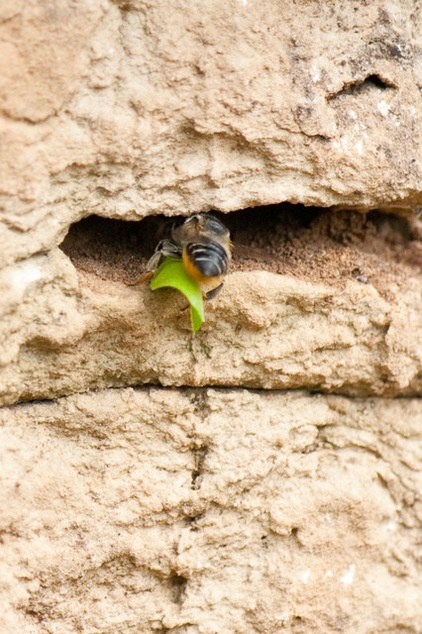
How to Spot Leafcutter Bees
Adult females. Leafcutter bees belong to a family of bees (Megachilidae) that have a unique location on their bodies for collecting pollen. Instead of collecting pollen on hairs or in a pollen basket on their hind legs (like most other female bees), female leafcutter bees collect pollen on several rows of hairs on their sternum (underside of their abdomen). As they forage on flowers, their sternum will turn the color of the pollen of the visited plants, usually orange or yellow, or occasionally blue or purple, as the pollen-collecting hairs become coated with pollen.
The other way to know that leafcutter bees are present and nesting nearby is when you find a plant that has oval or circular cuts on the leaves. The oval leaf pieces are used to line the area in their nests where the larvae are reared (called the brood cell); the circular pieces of leaves are used to close cells.
Female leafcutter bees have large mandibles, and most have a sharp, serrated cutting edge on each mandible that cuts the leaf as they collect leaf pieces on a plant. The large mandibles are visible, especially when you observe females from the side or head on. Leafcutter bees that lack these sharp cutting edges on their mandibles may seek out softer materials that are easier to cut, such as pieces of flower petals.
Adult males. In many cases the males do not resemble the females. They are often hairier than the females, have a flattened abdomen and are more robust in shape. One feature to look for on most male species is long hairs on their forelegs. Males cover the females’ eyes while mating with these hairs; odor glands on the forelegs help the females determine if she is mating with the right male (same species).
Shown: A female leafcutter bee carrying a leaf piece back to her nest in a hole in a rock
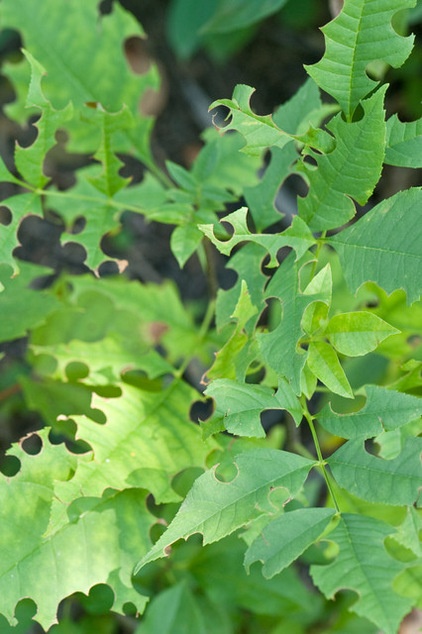
How to Lure Them
Leafcutter bees are generalist foragers and visit a wide variety of flowering plants throughout the summer. They commonly forage on open flower forms, such as asters or coneflowers, as well as more complex flower forms, including milkweed (Asclepias spp) and ticktrefoil (Desmodium spp).
Where they nest. Most leafcutter bees nest in cavities; a minority nest in the ground. Cavities include: holes in standing dead trees or logs on the ground, hollow plant stems, holes in rocks or cavities between rocks, holes made by a woodpecker or another insect and deep knot holes. Leafcutter bees have also been documented nesting in door keyholes, garden hoses and outdoor electrical outlets.
Maintain a bee-safe yard. Do not use pesticides, especially insecticides, in your garden, particularly on your flowering plants or on plants that have leaf cuts on the leaves. Once a female finds a preferable plant to collect leaf pieces from, she will make several trips to that plant while she is provisioning her nest. Remember that this occurs in a very short window of time, and the plant will not be harmed and will continue to grow; the cut leaves will be hidden by the new growth. The cut leaves can be manually removed if this is more aesthetically pleasing than leaving them on the plant.
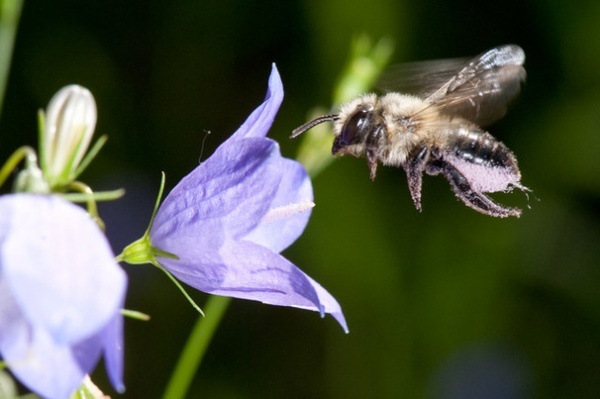
Forage plants for adults. All bees need a variety of flower forms and colors in the garden and a continuous succession of flowering. Leafcutter bees are active from June through September, when most gardeners have more than one plant flowering in a given week. If not, consider adding more flowering plants so that the buffet is always open to pollinators.
Some plants for adults:
Late spring: Harebell (Campanula rotundifolia), pale purple coneflower (Echinacea pallida), beardtongue (Penstemon spp) and prairie tickseed (Coreopsis palmata)Summer: Butterfly milkweed (Asclepias tuberosa), vervains (Verbena spp), yellow coneflower (Ratibida pinnata), anise hyssop (Agastache foeniculum), nodding onion (Allium cernuum), ticktrefoils (Desmodium spp), blazingstars (Liatris spp), swamp milkweed (Asclepias incarnata), Joe Pye Weeds (Eupatorium spp) and leadplant (Amorpha canescens)Late summer and fall: Stiff goldenrod (Solidago rigida) and New England aster (Symphyotrichum novae-angliae)Browse native plants for your region
Shown: Megachile gemula approaching a harebell (Campanula rotundifolia); note the violet-colored pollen collecting on the bottom of the abdomen
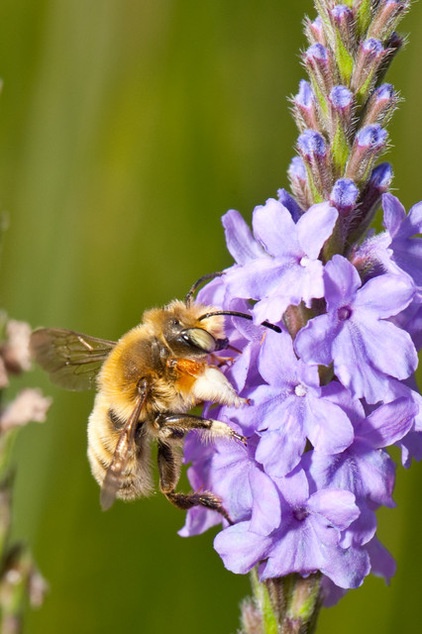
Life cycle. In the upper Midwest, Great Lakes and Northeast regions, leafcutter bees usually have one generation per year. Female leafcutter bees emerge from the nest as adults in late spring or summer, mate with males, then look for a suitable nesting site, usually in some kind of preexisting cavity. Females then begin collecting oval pieces of leaves to start lining the first brood cell. They overlap the leaf pieces to form a cylinder within the nest cavity (or in the ground).
The first provisions (pollen and nectar) are deposited in the leaf enclosure; females comb the pollen off their abdomen with their legs, depositing it in the leaf cylinder. An egg is laid when there is enough food for a larva to feed and develop on. The leaf enclosure is then capped with circular pieces of leaves to enclose the brood cell. This process is repeated several times in the cavity, and, depending on the species, materials including chewed-up leaf pieces or mud are used to make walls (divisions) between the brood cells. The same materials are also used to cap the cavity.
Females will construct and provision one to several nests during their lifetime.
Shown: A male leafcutter bee on hoary vervain (Verbena stricta); note the long, white hairs on the foreleg
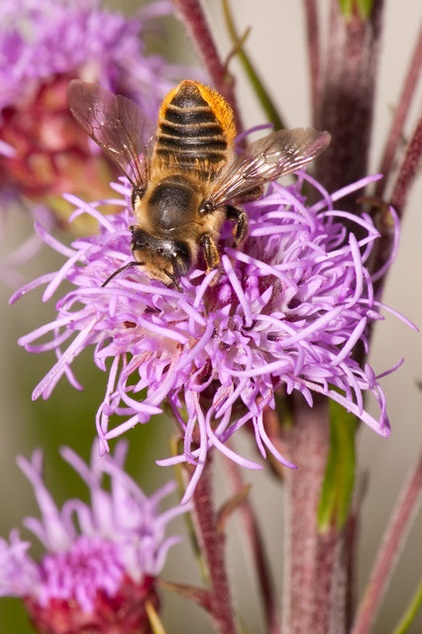
Most leafcutter bees overwinter as prepupae and finish their development the following spring, emerging as adults in late spring or early summer.
Leafcutter bees will also use human-made, supplemental nests. These nests are often made of wood with routered grooves to form the cavities. If you use supplemental nests in your garden, it is very important to clean the nests regularly (every two years). Paper nest liners are available for sale and can be easily removed and replaced. These liners help to keep the supplemental nests, including holes drilled in wood blocks, hygienic and safe for the bees to use.
Fossils of leafcutter bee nests have been found in Arizona in amber and in Southern California in tar pits. The California fossils date to the late Pleistocene era, approximately 126,000 years ago, and are beautifully preserved — some include pupae inside.
Shown: A female leafcutter bee foraging on meadow blazingstar (Liatris ligulistylis).
Region by region: What to do in your garden this month












